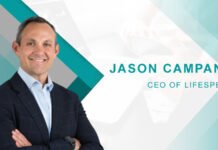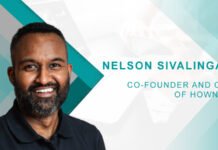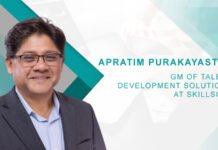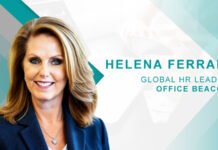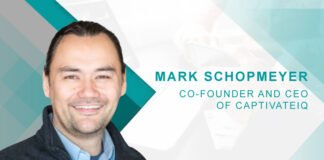HRTech has made HR leaders efficient in workforce and talent management. But can tech be assisted with a manual process to increase HR efficiency?
1. Being the CEO at Magnit, what’s your vision for the company?
We are in a brave new world. Businesses are fighting a war for talent, battling inflation, and navigating recession concerns at the same time. Leaders are under pressure to effectively manage talent on one end, and balance cost and spend on the other. Three of the most prevalent challenges I see clients and other organizations facing are:
• Cost: With Wall Street’s historic 12-year bull run coming to an end, cost savings are top of mind for leaders. Businesses are under intense pressure to cut costs as soon as they can and sustain those savings into the future.
• Talent: The hiring market that we’ve long known has changed. Many industries are finding themselves in a workers’ market, but they aren’t offering what workers want. It’s no longer about offering full-time employment in brick-and-mortar locations. It’s about opening flexible, hybrid opportunities to a global workforce.
• Fragmentation: Most businesses today are operating in a fragmented landscape, especially when they are implementing contingent workforces. They view each hire in isolation, as a one-off gig, temporary labor, or extra hands on a project. As a result, they fail to invest in programs that offer a 360-degree view of talent, spend or associated risk.
My vision is to shape the evolution of work by providing solutions that help companies overcome the significant challenges they face. Magnit offers the industry’s first technology-led, services-enabled and data-driven integrated management platform for contingent workforces. The Magnit platform helps organizations build a total talent management strategy that provides the flexibility to not only manage cost, but also most importantly attract and retain the right talent for the organization.
2. How can a brand establish talent management as an edge over competitors?
Today, the ability to hire and retain talent is top of mind in the C-suite. Over three-quarters of executives say it’s the most critical factor to achieving growth. As the competition for talent has grown fiercer, reliance on contingent work arrangements have become more popular with employers and employees alike. More than 80% of executives intend to expand their contingent, seasonal, intermittent or contract-based employees. As more companies wake up to the benefits of flexible workforces, the ones who will come out on top are those that make their contingent workforce part of their overall human capital strategy. This includes adopting new strategies to demonstrate an awareness of workers’ desire for remote options, improved work experiences, and commitment to diversity, equity and inclusion.
One method by which organizations are prioritizing their contingent recruitment is by deploying brand-enabled “direct sourcing” programs. This allows them to attract and engage known contingent workers without the help of a staffing agency. Ultimately, this involves nurturing a contingent brand that contains the values of a company’s talent brand while enhancing the relationship between contingent workers and the organization.
For example, a branded microsite can help provide a personalized candidate experience, leverage
deep-learning AI to surface job matches, and offer detail on why candidates are a good fit. Automation makes applying easier, and candidates can even join a company’s talent network and be notified of future opportunities that fit their interests and skills. The result is a more positive experience for candidates, while organizations get a boost to their brand and applicant volume/diversity. By addressing the contingent workforce as a core component to a company’s holistic talent management strategy, companies drive significant value and gain a competitive edge.
3. What are the best features of Magnit’s Workforce Management Platform?
Magnit’s Integrated Workforce Management Platform is comprised of modern software, proven expertise and world-class data and intelligence built to deliver the real-time intelligence organizations need to successfully source, track and manage their extended workforce. With the power of the industry’s first and only integrated platform, companies can adapt quickly to economic shifts with the speed, scale, flexibility, cost savings and expertise needed to shape and deliver the evolution of work.
Our platform has become the most advanced global workforce management solution on the market. It allows business leaders to think more strategically when managing contingent workers, which can reduce program spending by up to 40%. It eliminates the complexity of deploying disparate point products while giving companies ultimate flexibility. Furthermore, our commitments to diversity, equity and inclusion and vendor neutrality put us at the center of the evolution of work, delivering greater opportunities to workers and lower costs to employers. The platform includes:
• Vendor Management System (VMS), which enables organizations to manage, source and procure their extended workforce talent in a single AI/ML-driven system of record.
• Managed Service Provider (MSP), which is the industry’s most tenured and respected program of its kind and built on the foundation of pure vendor neutrality.
• Direct Sourcing solution, which enables organizations to leverage their brand to attract, curate and engage talent communities, directly fulfilling their hiring needs.
• Total Talent Intelligence (TTI) solution, which provides organizations with robust data so they can better understand and manage their total talent landscape
• Services Procurement solution, which combines data-driven intelligence, integrated statement of work (SOW) management technology, and best-in-class service delivery to provide organizations with the visibility and actionable insights needed to manage their SOW spend.
• Employer of Record (EOR) service, which empowers organizations to hire top talent anywhere in the world while delivering an elevated worker experience.
• Diversity, Equity and Inclusion (DE&I) solution, which enables clients to drive cultural inclusion and promote worker and supplier diversity by leveraging actionable insights.
4. Workforce management has a direct impact on business outcomes. Do you think HR’s input in employee experience is a driving factor?
For decades, the temporary staffing-agency supply chain has been a standard, efficient means of sourcing, deploying and managing an organization’s traditional contingent workforce. However, as organizations’ needs for different types of skills and expertise evolve, contingent worker skill levels and expectations rise, and digitalization transforms the world of work, organizations must modernize how they identify and connect with contingent talent.
This means designing, implementing and enabling processes that do more than generate new cost savings, reduce time to fill, and increase quality of hire (fit). Employers and HR leaders can help drive the attraction and engagement of contingent talent by prioritizing:
• Integration of enhanced worker engagement and experience initiatives into contingent workforce management programs
• Personalized outreach through direct sourcing
• The understanding of contingent workers’ needs
• Strong benefits packages that range from healthcare insurance and 401(k) options to remote work arrangements, on-demand payroll, and learning and development services
In short, contingent workforce sourcing and management must become more talent-centric and worker-focused and driven by HR and the C-Suite.
5. PRO Unlimited was recently rebranded to Magnit. What inspired this move?
The nature of work itself is changing, and our company is evolving alongside it. For the past 30 years, PRO Unlimited has been known for its work shaping the direction of the contingent workforce industry alongside some of the world’s most notable brands. In that time, we have evolved from a professional services company into an industry-leading integrated workforce management platform, connecting organizations with the best talent while helping them prepare for the evolution of work. We believe Magnit fully embodies who we are today and reflects our vision for the future.
6. Could you highlight some of the best contingent workforce management strategies?
Peter Drucker once said, “you can’t manage what you cannot measure” — and I would add “you can’t measure what you cannot see.” Most organizations’ contingent workforce management programs are focused on temporary staffing suppliers. While there are opportunities to reduce costs and optimize spend in that arena (by using real-time rate intelligence, for example), expanding program scope with total talent intelligence as the foundation is the best approach for leaders who want to see everything.
Having a program based on comprehensive talent intelligence is what enables the quantum change in program benefits companies need. Fundamentally, program expansion means capturing more and more spend under management, so it can be optimized. It also means incorporating additional sourcing channels that increase access to talent and optimizing channel selection for cost and performance.
Using direct sourcing coupled with EOR is a sure bet for cost reduction. Expanding program scope also means moving beyond the procurement focus on sourcing to full lifecycle contingent talent management, which can elevate contingent worker experience and save time and cost through better retention and a higher rate of redeployments.
7. What’s the difference between EOR and PEO?
An EOR is a partner that assumes the responsibility for providing payroll, administering benefits, and managing risk for the client’s extended workforce. The integrated service provides comprehensive payroll and industry-leading benefits to attract and retain top talent while ensuring global scale and compliance with local labor laws.
A PEO requires an organization to own its own local entity in a specific country or region, whereas the EOR can employ workers in other countries or regions on an organization’s behalf without opening an entity in that country. Lastly, the EOR acts as the legal employer of workers. In contrast, with a PEO there is a co-employment arrangement with a company and its employees.
8. How do organizations benefit from a Vendor Management System?
Typical positive business outcomes of strategically employing a leading-edge Vendor Management System include:
• Cost savings, with companies typically savings 6-11% in an area where they spend millions of dollars (if not billions)
• Improved cycle times from streamlined, automated processes with uniformity and consistency
• Mitigated risks associated with contingent personnel (including co-employment and compliance with changing laws)
• Enhanced access to higher-quality labor resources from higher-quality suppliers
• Company-wide tracking and reporting on spending, headcount, supplier performance and more
• More informed DE&I strategies through the secure collection of self-identified diversity data
• Strategic use of a flexible workforce to access specialized skill sets and adapt to organizational needs
In short, the VMS connects all users — from hiring managers to suppliers to talent — with persona-based user experiences and data at the point of decision, providing business leaders with greater visibility, more transparency, and better control of their integrated workforce.
9. Which types of behavior traits make for effective leadership?
I believe that true leadership comes, first and foremost, from having empathy. In order to lead, you must be human. You also must embrace transparency by prioritizing clear, open communication throughout your organization. It’s the backbone of all relationships, and you cannot build trust without it.
I also admire leaders who lead from the front — those who are willing to jump in and lend a hand alongside employees, regardless of paygrade. Engaging with staff in this way can help reinforce the company’s guiding mission and inform leadership about what’s working and what’s not. This information helps leaders maintain a forward-looking approach and make decisions with confidence. When they do that, it’s hard not to trust their lead.
10. You’ve led Magnit to achieve new heights in the HCM space. You also led one of the largest PR software companies, Cision, for over 3.5 years. How have you been this successful at driving innovation and revenue growth?
Driving innovation is about releasing and directing it based on a compelling vision, exceptional talent and optimal organizational structure.
While innovation drives medium-term and longer-term revenue, short-term revenue growth depends on driving operational effectiveness, meeting customers’ immediate needs and expectations, and layering in innovation.
To do this, we prioritize:
o Hiring, promoting or developing the best leadership at all levels
o Creating an organization that’s driven by the goal of supporting the entire global workforce, including enabling professional growth and encouraging well-being
o Pursuing a three-legged strategy focused on organic, M&A and partnerships to drive growth
o Re-aligning our solution development and go-to-market to add more value in our client relationships
o Implementing deliberate change management strategies focused on frequent and honest communication.
My timing at Magnit was good because it was apparent that the industry was primed for transformation. Taking it to the next level meant painting a much bigger (and more accurate) picture of the market and showing prospective clients that we were going to be the ones that would shape and deliver this next chapter in the evolution of work.
For more such Updates Log on to www.hrtechcube.com

Kevin Akeroyd Chief Executive Officer, Magnit
Kevin Akeroyd serves as Magnit's Chief Executive Officer and leads the vision and strategy for the company. He is recognized as one of the technology industry's most tenured and trusted experts. Kevin has held executive leadership roles at some of the world's most notable brands that were category leaders in Cloud Software, Services and Data. Prior to Magnit, Kevin served as Global CEO at an industry leading SaaS Marketing and Communications software provider, where he took the company public on the NYSE before selling it for $2.8B.

